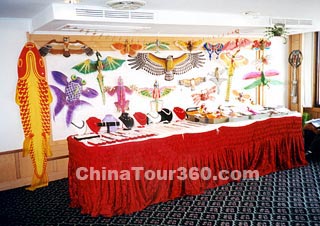The earliest kite in the world was made by Mo-tse, a famous Chinese philosopher, who lived 2,300 years ago, and was used for military purposes. He spent three years making an eagle and managed to fly it. The eagle later was regarded as the first kite in the world. Kite flying became a recreation during the Tang Dynasty (618 - 907) when the royal family and aristocrats became addicted to it. It was said that the Emperor Xuanzong in the Tang Dynasty once was deeply attracted by a kite named Eight Immortals Crossing the Sea, when he saw it flying in the air. The invention of paper decreased the cost of kites, so they quickly spread among the common people. As time went on, kites were flown throughout the world. The British scientist, Dr. Needham, once described kites as an important scientific invention spread to Europe from China in his book, A History of China's Science and Technology. The invention helped to arouse the dream of mankind to fly and led to invention of airplane.
|
|
![]() Kite Making
Kite Making
Kite making is a traditional Chinese folk handicraft. Those made in Tianjin, Beijing and Weifang are considered superior to other styles.
Tianjin is well known for its kite making and the most famous craftsman in Tianjin was Wei Yuantai, nicknamed Kite Wei. He had been made kites for more than 70 years. The first one made in China was a butterfly or eagle shape with a rigid framework. The selection of materials was limited and the craftsmanship was clumsy. Mr. Wei developed some 200 types with many new structures and designs, such as flat hard-winged, soft-winged, three-dimensioned and foldaway types, being the most noticeable. It has a flexible bamboo tendon framework secured with glue instead of thread, and reinforced by a copper ring at every joint. Kites, up to three meters long can be folded and held in a very small box. More than fifty kinds made by Wei have been exhibited at home and abroad. In 1915, Wei Yuantai's kites won a gold medal and a certificate of merit at the Panama-Pacific International Exposition in San Francisco. Wei's kites have obvious attributes, such as fine craftsmanship, vivid appearance and good balance. Later generations of Wei inherited and developed these strong points. Wei Yonghang, the third generation of Wei Yuantai, developed more than 50 new designs based of old Wei designs.
Beijing is also famous for kite making. With a large variety of shapes, Beijing kites are made of paper or silk and painted totally by hand, have a good market reputation at home and abroad. The most experienced craftsman in Beijing is Fei Baolin, who developed several hundred kinds of kites in different shapes and sizes. The smallest is able to fit in the palm of the hand.
Weifang in Shandong Province also is famous for its kite making and flying customs. Each year, Weifang International Kite Festival is held in April, and kite enthusiasts from all over the world take part and compete in the festival.









